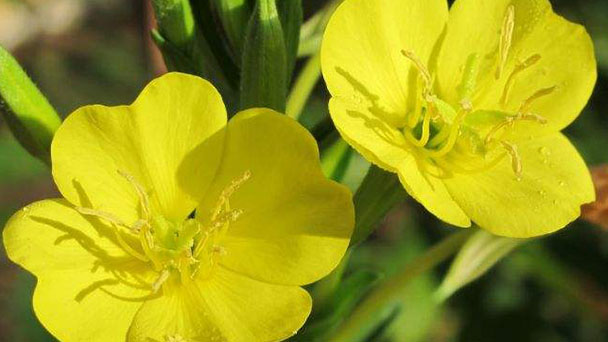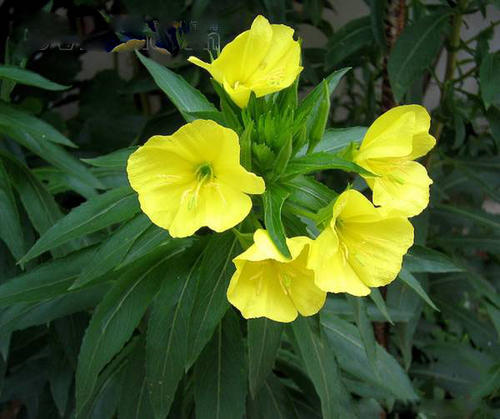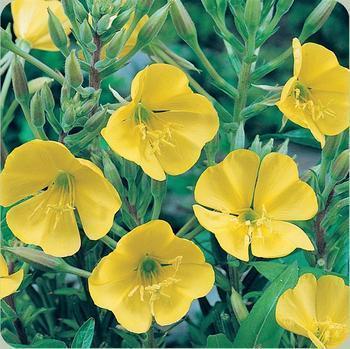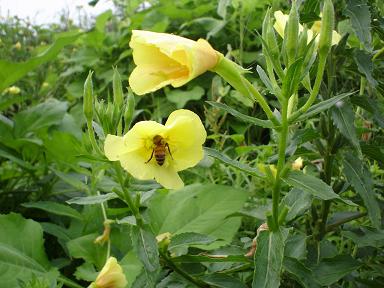Oenothera biennis profile
Written by Maggie
Nov 25 2020

Oenothera Biennis is suitable for cultivating in the courtyard ventilated and bright place. It can also be potted and placed on the balcony for viewing. Under the moonlight on a still night, the faint fragrance makes people feel refreshing.Oenothera Biennis self-seeding ability is very strong. Once after planting, its self-seeding seedlings can be self-seeding every year, bloom continuously. Let's take a look at the details of Oenothera Biennis.
Oenothera Biennis picture

The morphological characteristics of Oenothera Biennis
Oenothera Biennis is an erect biennial coarse herb, basal rosette close to the ground. The plant is 1.5 ~2 m tall, root terete, stem 50~200 cm tall, unbranched or branched, covered with curved pilose and extended long hairs (basal blisters of hairs), often mixed with glandular hairs at upper end of stem branches.Seedling stage is rosette, base has red long hair. Leaves are alternate, lower stem straight stalked, upper leaves subsessile. The leaf is blade oblong, lanceolate, 6 ~ 9 cm long, 1.5 ~ 3 cm wide, margin sparsely serrate, white pilose on both surfaces.The flowers were arranged in a sparsely tasseled, calyx tube slender, apex 4-lobed, lobes reflexed.I has 4 Petals, yellow, stamens 8,4 opposite petals.Pistil 1, stigma cleft. Capsule is cylindric, apex acute, outer apex acute, outer covered with long white hairs, dehiscent naturally after maturity. Seeds are small, brown, irregular trigonal shapes.
The growth habits and distribution of Oenothera Biennis
Oenothera Biennis is always open and has a barren slope roadside. It is drought resistant. Barren, black soil, sandy soil, loess, young forest land, light saline-alkali land, unreclaimed land, river land, mountain slope land are suitable for planting.
Oenothera Biennis is native to North America (especially Canada and the eastern United States). It was introduced to Europe in the early stage and quickly spread to temperate and subtropical regions of the world. It is cultivated in northeast China, North China, East China (including Taiwan) and southwest China (Including Sichuan and Guizhou), and has long been reduced to a stray, transcaucasian and Far East pastoral area. As early as the early 1950s, it has been used as a fine grass species for artificial pasture construction.

The utility value of Oenothera Biennis
Oenothera Biennis medicinal value
Oenothera Biennis can reduce blood fat and anti-atherosclerosis effect, weight loss effect, anti-fatty liver effect, antiarrhythmic effect, anti-inflammatory effect
Oenothera Biennis Economic Value (Making Oenothera Biennis oil)
Oenothera Biennis flowers are beautiful, often cultivated for ornamental use. Flowers can be extracted from aromatic oil. Seeds can be pressed oil for edible and medicinal purposes. The cordage can be made from stem and skin fibers. The seed oil content was up to 25.1 {bf}, and Y~ linolenic acid was up to 8.1 {bf}, which was the most promising species.
Oenothera Biennis oil is the main ingredient in many natural cosmetics. Oenothera Biennis contains high concentrations of fatty acids and linolenic acid psoriasis (GLA), which prevents and treats psoriasis, eczema, and other skin symptoms. Oenothera Biennis can also hold water. Essential fatty acids keep nails healthy and prevent breakage, and nourish the scalp and hair.
Latest Updated
- Benefits of Bugleweed - 7 Science-backed Health Benefits
- Bugleweed Dangers & Side Effects - Is It Poisonous?
- How to Plant Evergreen Trees - What You Should Know
- When to Plant Evergreens - Grow Guide for Evergreen Trees
- 12 Wonderful Evergreen Shrubs for Your Garden
- 12 Popular Evergreen Plants with Pictures for Beginners
- When And How To Prune A Lilac Bush Like a Pro
- How to Grow & Care for Lilac Vine (Hardenbergia Violacea)
- Japanese Lilac Tree (Syringa Reticulata) Care & Propagation Guide
- Shumard Oak Pros and Cons - What to Know
Popular Articles
- Winter maintenance of Antirrhinum Majus
- How to Grow Terminalia Mantaly Tree
- How to Grow and Care for Crossostephium Chinense
- How to grow Antirrhinum Majus in spring
- Peristeria Elata (Dove Orchid) Profile: Info & Care Guide
- Underwatered Snake Plant (Sansevieria Trifasciata) - Signs And How To Fix
- How to Care for Brazilian Jasmine Plant (Mandevilla Sanderi)
- How to Grow & Care for Graptopetalum Purple Delight in Summer
- Rosa Chinensis (China Rose): Plant Growing & Care Tips
- How to Care for Baby Sun Rose (Aptenia Cordifolia)